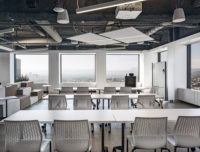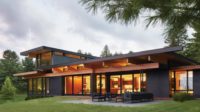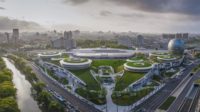Despite all the digital design tools at its disposal, R&A Architecture + Design occasionally achieves better results with an analog process. Case in point: BCG Digital Ventures, a quickly growing products incubator, hired the five-year-old architecture practice to create its new North American Center, on two floors of a 1980s-era building in California’s Manhattan Beach, just minutes from the sand.
Early on, the client’s need for flexible workspaces that could satisfy accounts people one day and creatives the next led R&A principal Christian Robert and his team to render their ideas in one of the most accessible and flexible materials around—cardboard moving boxes. Using them to mock up full-scale conference tables and walls, they found a solution to BCG’s challenge of accommodating the work styles of three distinct teams—in ways that help them collaborate, not collide. The company’s business consultants and strategists, for example, needed breakout rooms for joint work sessions, designers required plenty of flat work surfaces and wall space for vetting drawings and renderings, and engineers had to have permanent, quiet workstations.
“The client said, ‘Don’t give me just an open floor plan,’ ” Robert recalls. “They’d had a bad experience with [standard] open offices. Designers and software developers were stuck in open areas, and consultants hogged the conference rooms.”
Some clients might be put off by the sight of architects unfurling U-Haul-box prototypes, but as a company accustomed to bringing its own products to fruition through experimentation, BCG was delighted by R&A’s approach. The client even kept the cardboard models for internal presentations to employees, asking the architects to make a second “working” set. Not only had R&A hit upon a solution for the awkward 45-degree angles of the Manhattan Beach office floor plan, but it also landed on a template that BCG wanted to roll out to satellite offices in New York, London, Seattle, Shanghai, Sydney, and several other cities around the world. They would use a series of hexagonal project spaces, dubbed Venture rooms, to create more wall-display space than you’d find in a square room. Custom-made movable rhomboid tables would be adapted to each team’s needs. The almost-circular spaces have an effect analogous to that of a round dining table—no one is at the head, so hierarchies (ideally) dissolve.
In some iterations, more glass is added to the design. “The transparency allows [collaborating] teams [who share a project] to know what [counterparts] are working on,” says Robert. “There is cross-pollination.”
Clients and staff navigate the 54,000-square-foot Manhattan Beach office along an internal “beach walk,” a pathway of Maxwood veneer flooring with a noise-reducing cork backing. Being able to see into the glass-enclosed workspaces helps orient them to the correct project. The walkway provides a slight separation between.






Post a comment to this article
Report Abusive Comment